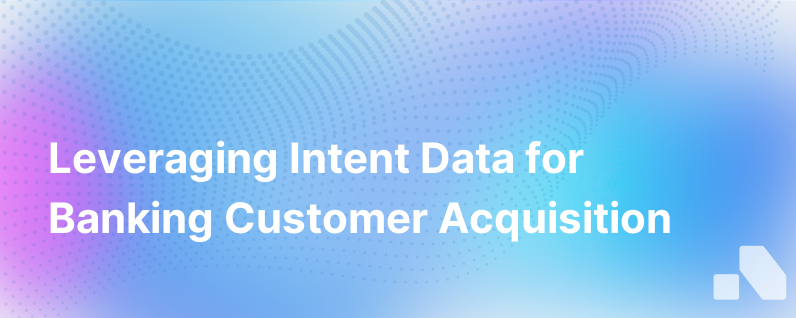
In the whirlwind of digital evolution, banks face the pressing challenge of attracting new customers, amidst a sea of competitors and evolving customer expectations. To gain an edge in this fiercely competitive landscape, intent data emerges as a North Star, guiding banks to pinpoint and engage with prospective customers actively signaling a readiness to procure banking services. This strategic use of intent data could redefine a bank's customer acquisition efforts, fueling more personalized, timely, and impactful engagements.
Let's dive into how banks can leverage intent data to sift through the digital noise and systematically identify, woo, and win over new customers.
Understanding Intent Data
Intent data captures and reflects the digital signals that users leave behind when they navigate online – it's the digital body language indicating interest or purchase intent. For banks, this information comprises website visits, content interactions, search queries, form submissions, and social media engagement, all of which can signal a consumer's interest in financial products or services.
The crux of successful intent data utilization lies in banks' capacity to discern behavioral patterns, thus anticipating and meeting customer needs with greater precision. By effectively harnessing intent data, banks can transition from a traditional product-centric approach to a customer-centric model that delivers relevance at every touchpoint.
Benefits of Intent Data for Banks
Before delving into implementation strategies, let's crystallize why intent data is transformative for banks:
- Enhanced Lead Targeting: By identifying prospects showing interest in financial services, banks can tailor their outreach, making it more relevant and effective.
- Increased Conversion Rates: Intent data equips banks to engage with prospects when their interest is peaking, leading to higher conversion probabilities.
- Improved Customer Experience: By understanding what potential customers are looking for, banks can deliver personalized experiences, setting the stage for loyalty.
- Informed Product Development: The insight garnered from intent data can guide banks in creating or optimizing services that align with customer expectations and needs.
How Banks Can Use Intent Data
Adopting intent data requires meticulously intertwined sales, marketing, and IT efforts. Here is a stepwise approach for banks looking to employ intent data in their customer acquisition strategy:
Step 1: Data Collection and Integration
The first step is gathering intent data from various sources, including first-party data from the bank's digital assets and third-party data from platforms tracking wider web behavior. Integrating this data is paramount, as it provides a unified view of potential customer behavior. Technologies such as Data Management Platforms (DMPs) or Customer Relationship Management (CRM) systems can assist in assimilating this information.
Step 2: Data Analysis and Insight Generation
Once the data is compiled, banks must employ analytics, often powered by artificial intelligence (AI), to glean actionable insights. Insights include identifying individuals conducting research on mortgages, searching for high-interest savings accounts, or business owners looking into small business loans—indicating specific banking needs.
Step 3: Audience Segmentation
Armed with intent data insights, banks can segment audiences based on their expressed interests, behaviors, and preferences. A properly segmented audience allows for more focused and effective marketing campaigns.
Step 4: Personalized Marketing Efforts
Intent data empowers banks to create personalized marketing strategies. For instance, if a user has been browsing mortgage-related content, the bank can send personalized communication discussing their latest mortgage rates or invite them to a webinar on home buying tips.
Step 5: Sales Alignment
Sales teams, equipped with intent data insights, can nurture leads with a more conversational approach, armed with knowledge about the prospect's interests and potential pain points. They can also prioritize leads based on who’s showing the strongest purchase intent.
Step 6: Measure, Optimize, Repeat
Finally, tracking the outcomes of intent-based marketing campaigns is critical. Banks need to measure whether leveraging intent data translates to an improved conversion rate. Continuous optimization is vital for iterative improvement in targeting new customers.
Challenges and Considerations
While intent data is a potent tool, there are several challenges and considerations banks need to account for:
- Privacy and Compliance: Banks must navigate stringent privacy regulations and ensure compliance while collecting and utilizing intent data.
- Data Accuracy: It's essential for banks to source high-quality intent data to ensure the information they act on is accurate and up to date.
- Cross-Channel Coordination: Coherent communication across channels, based on unified intent data, ensures consistency in customer engagement.
- Infrastructure and Expertise: Banks need the right infrastructure and expertise to analyze and act upon the data.
Real-world Applications
JPMorgan Chase, for example, has leveraged intent data to expand into new territories. By analyzing prospective customers' online behaviors, they identified regions with higher demand for their financial products and prioritized their marketing and branch expansion efforts accordingly.
A regional bank might use intent data to discern surging interest in small business loans in its locality due to a growing startup scene. By targeting this segment with specific, helpful content and offers, they can capture a significant share of this budding market.
Conclusion
In the race to acquire new customers, banks that effectively harness intent data can ensure they're not just fishing in the largest pond, but fishing where the fish are biting. As financial institutions become increasingly data-savvy, the astute analysis and application of intent data will differentiate the leaders from the laggards.
For banks eager to transform their customer acquisition strategies, tools that seamlessly integrate and analyze intent data - such as Aomni - could offer the competitive advantage needed to elevate their efforts above traditional marketing and sales methods. As banks master the use of intent data, they will find themselves navigating the path to new customer growth with an unprecedently clear compass.